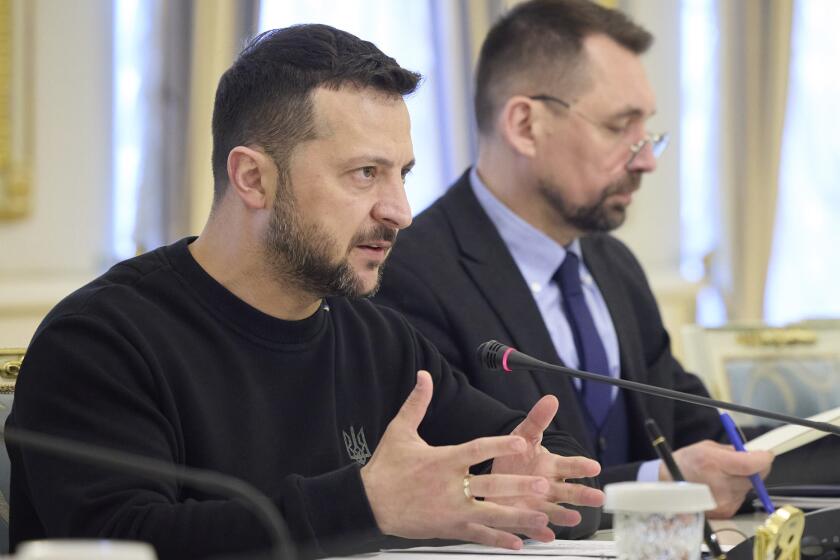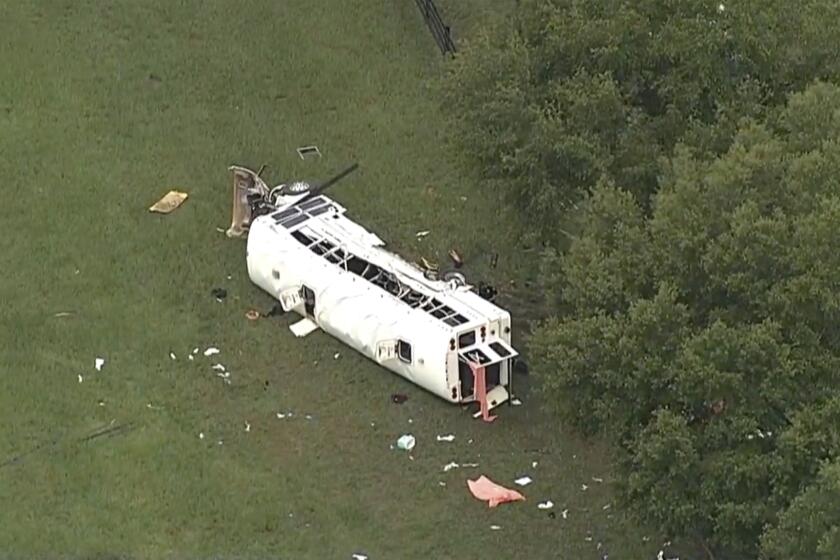Kashmir Militants Lend a Hand
In the eyes of earthquake survivors, the heroes in this devastated valley are not soldiers or relief workers, but guerrillas notorious for suicide bombings and kidnappings.
The magnitude 7.6 quake destroyed about 100 mud-brick homes and a mosque in this village on the morning of Oct. 8. For the first six hours, injured and terrified villagers were on their own as they tried to save those dying in the rubble.
Then, more than 15 militants arrived from a camp concealed in the mountaintop pine forest above Saloona. They even brought their own medics.
“They provided emergency treatment to the injured,” said villager Haisa Khan, 65. “They started removing people trapped under the debris. They rescued people we couldn’t. Then they dug graves for the dead.”
President Pervez Musharraf has repeatedly assured U.S. and other foreign officials that he has dismantled militant training camps on Pakistani territory. But interviews with villagers and militants in several regions of North-West Frontier Province and the Pakistani-controlled part of Kashmir in recent days indicate that a disciplined and well-organized network of guerrilla groups still exists.
Some of the militant groups fighting Indian rule in the state of Jammu and Kashmir have been linked to Osama bin Laden’s Al Qaeda network, and to the Taliban in neighboring Afghanistan. The Kashmiri militants also have long been associated with the Pakistani military’s Inter-Services Intelligence agency.
In this valley about 70 miles north of Pakistan’s capital, Islamabad, villagers say militants from a camp run by the Al Badr Mujahedin were the first responders to the quake, which killed 17 people in Saloona and injured four others, including a boy who said militants had tended to his broken ankle after rescuing him from the rubble of his home.
Al Badr is one of about a dozen guerrilla forces fighting in the Indian-held portion of Kashmir. It is one of the smaller factions, but India’s security forces consider it a ruthless terrorist group whose tactics include suicide bombings, which are rare in Kashmir.
Last year, the State Department’s annual report on global terrorism estimated that Al Badr had several hundred fighters. They operate in Jammu and Kashmir state, Afghanistan and Pakistan, the report said.
“The group was relatively inactive until 2000,” the report added. “Since then, it has increasingly claimed responsibility for attacks against Indian military targets.”
Although India and the U.S. have declared Al Badr a terrorist organization, it is not on Pakistan’s list of 16 banned militant groups. It has had a camp on Tanglai mountain for at least six or seven years, villager Khan said.
The people who live in the villages scattered throughout the valley below the camp say they rarely see the militants unless there’s an emergency and they come to provide aid.
“They are busy with their own kind of work,” said Abdul Rehman, 25, in the village of Bhaibela. “They don’t disturb us. They keep to themselves, but always help us when we need anything.”
The villagers’ only complaint about the militants was that their donated tents leak in the rain that has drenched the region as winter approaches.
India’s security forces have reported clashes with Al Badr militants as recently as this summer. In July, Al Badr militants were involved in the kidnapping of five civilians whose bodies were later found on the outskirts of Srinagar, summer capital of Jammu and Kashmir, the security forces say.
In February, Al Badr claimed responsibility for a raid on a government building in Srinagar in which at least five people, including two attackers, died.
Investigators linked the same group to the July 2003 suicide bombing of a minority Shiite Muslim mosque that killed at least 53 people in the southern Pakistani city of Quetta.
But in these parts, Al Badr has a sterling reputation. It’s the army and the government that locals don’t like. Villagers say the only soldiers they have seen since the quake were on their way somewhere else.
“We waved at them, but they didn’t stop,” said Zeenat Khan, 32, in Bhaibela. “We begged them, ‘Please give us some tents,’ but they ignored us.”
On the day of the quake, villagers say, two militants from the Al Badr camp arrived to survey damage in the area and then climbed back up the mountain to their base.
Hours later, 14 militants arrived in Bhaibela with two canvas tents and their medics, who bandaged wounds and distributed basic medicine such as cough syrup and pain relief tablets, villagers said.
“For the first two or three days, they made regular visits,” Rehman said. “But they also had suffered some losses, so they were busy at their camp.”
Ten days after the quake, army troops leading the relief effort still hadn’t reached thousands of villagers isolated by landslides and the raging Neelum River.
But high in the mountains, fighters in the outlawed Jaish-e-Mohammed force were trekking along dirt tracks to deliver food, medicine and plastic tarps to desperate survivors.
Musharraf banned the group in early 2002 when he announced the first of several crackdowns on militant organizations. India blames Jaish militants for a December 2001 assault on its Parliament, which left 12 dead, including the five attackers. The incident inflamed long-standing tensions between India and Pakistan.
A long-bearded militant, who identified himself only as Muaz, said his group of 14 Jaish-e-Mohammed militants and local guides was delivering relief to Parian, a town flattened by the quake.
“We’re short of colleagues in this particular area because we have dispatched others to different quake-stricken areas,” Muaz said.
Naeem ul Hassan, a guide from nearby Patika, said more than 500 people had died in his area, mostly schoolchildren.
“No army or medical team has arrived in our area,” he said, although he acknowledged that many soldiers at a nearby military camp had died in the quake. “We are only getting relief through the mujahedin.”
In Muzaffarabad, capital of Pakistani-controlled Kashmir, the quake destroyed the office of Jamaat ud Dawa, an officially tolerated branch of Lashkar e-Taiba, which was banned in 2002. Jamaat’s members set up a medical relief camp amid the ruins. The long-bearded men working there are sensitive about any mention of guerrillas.
“If you are going to relate this work with the militants, then I am not going to talk to you,” spokesman Mohammed Azad told a visiting reporter. “This is very much welfare work.”
The group’s members, who coordinate their effort in several districts by walkie-talkie, said they had 100 doctors treating injured survivors.
“Our ‘elders’ have ordered us to carry out this relief work until the local population has recovered,” Azad said.
*
Special correspondents Mubashir Zaidi in the Neelum Valley, Pakistan, Khawar Ghumman in Muzaffarabad and Shankhadeep Choudhury in New Delhi contributed to this report.
More to Read
Start your day right
Sign up for Essential California for news, features and recommendations from the L.A. Times and beyond in your inbox six days a week.
You may occasionally receive promotional content from the Los Angeles Times.





